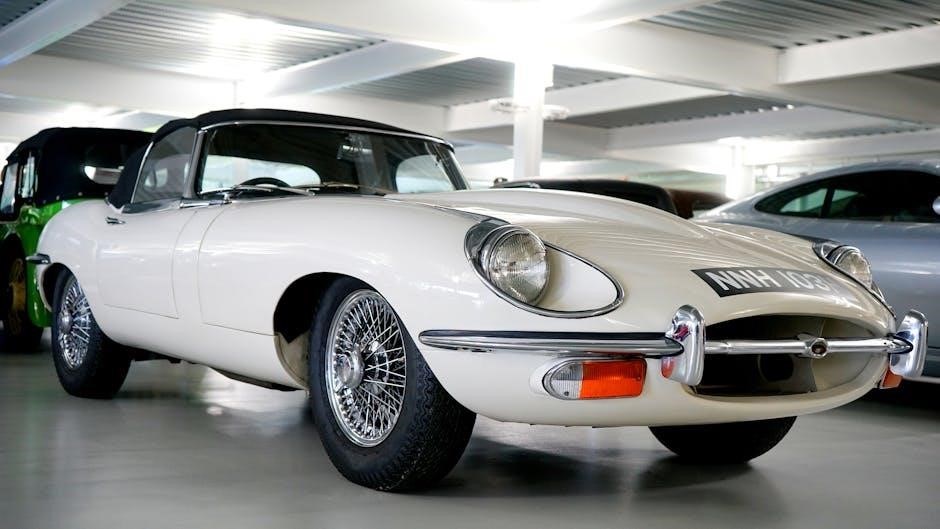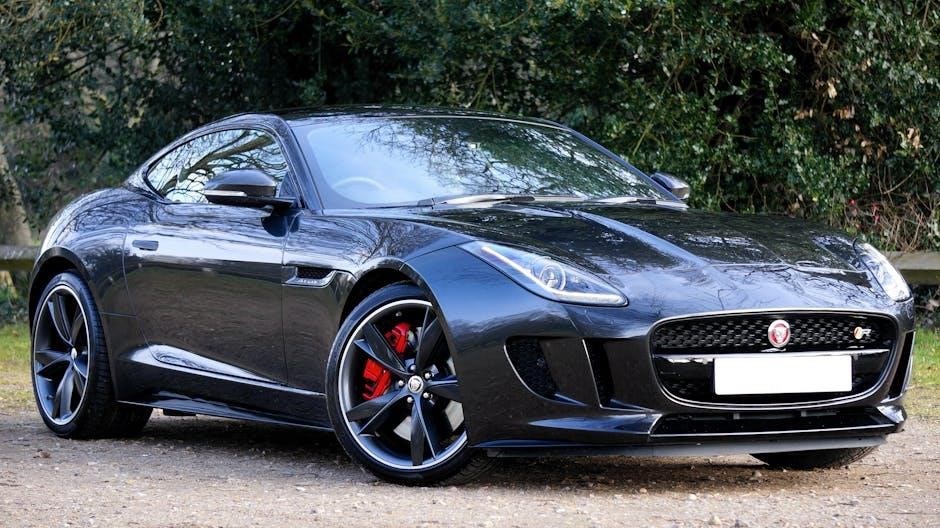
Jaguar S-Type Buying Guide
Embarking on the journey of purchasing a Jaguar S-Type requires careful consideration. This guide will help navigate the model years‚ highlighting potential problems and maintenance needs. Researching common issues and service history ensures a confident purchase‚ leading to a rewarding ownership experience.

Model Years to Consider
When considering a Jaguar S-Type‚ certain model years stand out as potentially more reliable and enjoyable to own. Models manufactured in 2008‚ 2007‚ 2006‚ 2004‚ and 2002 are often cited as the best choices. These years generally have fewer reported problems compared to others‚ based on auto industry reviews‚ NHTSA statistics‚ and consumer feedback. Opting for these later model years can potentially reduce the likelihood of encountering common issues such as cooling system failures‚ transmission problems‚ or electronic glitches. The 4.2L S-Type‚ particularly from these recommended years‚ is considered one of Jaguar’s more reliable models. Furthermore‚ these models often benefit from design improvements and refinements implemented over the S-Type’s production run. While a thorough pre-purchase inspection is always essential‚ focusing on these model years can increase your chances of finding a well-maintained and dependable S-Type. Remember to prioritize models with documented service history to ensure proper maintenance and care throughout their lifespan. Choosing a model from these years can offer a balance of classic Jaguar styling and improved reliability.
Model Years to Avoid
Conversely‚ some Jaguar S-Type model years are known to have a higher incidence of problems‚ making them potentially less desirable choices for buyers. Specifically‚ models from 2000‚ 2001‚ 2003‚ and 2005 are frequently mentioned as years to avoid due to a greater number of reported issues. These earlier models are statistically more likely to experience cooling system failures leading to engine overheating. Automatic transmission problems also surface more often in these years. Suspension problems‚ resulting in costly repairs‚ and sporadic electronic glitches affecting various in-car systems are also common. The 2000 Jaguar S-Type‚ in particular‚ often has the highest number of reported problems. While well-maintained examples from these years may still be found‚ the risk of encountering significant repairs is statistically higher. Potential buyers should proceed with extra caution and consider a very thorough pre-purchase inspection. Scrutinize the service history for evidence of preventative maintenance addressing common issues. Be prepared for potential expenses related to known weaknesses in these model years. If possible‚ prioritize later‚ more reliable model years to minimize the chances of costly repairs and maximize your enjoyment of the S-Type.

Common Problems: Cooling System
A recurring issue plaguing the Jaguar S-Type‚ particularly in earlier models‚ is related to the cooling system. Owners have frequently reported cooling system failures that can lead to the engine overheating. This is a significant concern‚ as overheating can cause severe engine damage‚ resulting in very costly repairs. The cooling system of the S-Type is complex and includes various components such as the radiator‚ thermostat‚ water pump‚ hoses‚ and expansion tank. Any of these parts can potentially fail‚ leading to leaks‚ reduced coolant flow‚ and ultimately‚ overheating. Regular maintenance and inspection of the cooling system are essential to prevent these problems. Look for signs of coolant leaks around hoses‚ the radiator‚ and the water pump. Pay attention to the temperature gauge and be alert to any fluctuations or indications of overheating. A pressure test of the cooling system can help identify leaks that may not be immediately visible. Replacing coolant at the recommended intervals is also vital to prevent corrosion and maintain optimal cooling efficiency. Addressing cooling system issues promptly can prevent more serious and expensive engine repairs. Owners of older S-Types should be particularly vigilant about cooling system maintenance.

Common Problems: Transmission
Another common issue reported by Jaguar S-Type owners involves the automatic transmission. Transmission problems can manifest in various ways‚ including rough shifting‚ slipping gears‚ or complete failure. These issues are often attributed to the complexity of the transmission system and the sensitivity of its electronic components. Regular transmission fluid changes are crucial for maintaining optimal performance and preventing premature wear. Neglecting fluid changes can lead to a buildup of contaminants and decreased lubrication‚ ultimately causing damage to the transmission. Owners should adhere to the manufacturer’s recommended service intervals for transmission fluid replacement. When test-driving an S-Type‚ pay close attention to how smoothly the transmission shifts between gears. Any hesitation‚ jerking‚ or unusual noises could indicate underlying transmission problems. It’s also advisable to have the transmission inspected by a qualified mechanic before purchasing an S-Type‚ especially if the vehicle has high mileage or a history of transmission issues. Rebuilding or replacing a faulty transmission can be an expensive repair‚ so identifying potential problems early on is essential. Some owners have also reported issues with the transmission control module (TCM)‚ which can affect shifting performance. Addressing transmission issues promptly can help prevent further damage and extend the life of the transmission.
Common Problems: Suspension
The Jaguar S-Type‚ known for its luxurious ride‚ can experience suspension-related issues. Many owners have reported problems with the suspension system‚ particularly with the air suspension components found on some models. Air suspension failures can lead to a bumpy ride‚ uneven vehicle height‚ or complete suspension collapse. These failures often stem from leaks in the air struts or a malfunctioning air compressor. Regular inspection and maintenance of the air suspension system are essential for preventing costly repairs. Another common suspension problem involves worn-out suspension bushings and ball joints. These components can deteriorate over time‚ resulting in excessive play‚ noise‚ and poor handling. Replacing worn-out bushings and ball joints can improve ride quality and restore proper suspension geometry. Owners should also be aware of potential issues with the electronic stability control (ESC) system‚ which relies on various sensors and actuators to maintain vehicle stability. Malfunctions in the ESC system can lead to erratic handling or warning lights on the dashboard. Suspension problems can significantly impact the S-Type’s ride comfort and handling‚ so addressing these issues promptly is crucial. A thorough inspection of the suspension system is recommended before purchasing an S-Type‚ especially if the vehicle has high mileage or a history of suspension problems.
Common Problems: Electronic Glitches
The Jaguar S-Type‚ while a vehicle of refined luxury‚ is known to be susceptible to various electronic glitches. Owners have reported issues ranging from minor inconveniences to more significant system failures. These glitches can manifest in various ways‚ including problems with the infotainment system‚ navigation system‚ and climate control. Intermittent electrical faults can also affect the car’s lighting‚ power windows‚ and central locking system. One common issue is the failure of the instrument cluster‚ leading to inaccurate readings or complete loss of functionality. Another frequent complaint involves the car’s electronic control units (ECUs)‚ which can malfunction and trigger warning lights on the dashboard. These ECU problems can affect various systems‚ including the engine‚ transmission‚ and braking system. Diagnosing electronic glitches in the S-Type can be challenging‚ as the root cause may not be immediately apparent. A thorough diagnostic scan using specialized equipment is often necessary to pinpoint the source of the problem. Repairing electronic issues can also be costly‚ as it may require replacing faulty sensors‚ modules‚ or wiring harnesses. Owners should be aware of these potential electronic vulnerabilities and factor them into their maintenance budget. Regular maintenance and prompt attention to warning lights can help prevent more serious electronic problems from developing.
Engine Reliability (V6 and V8)
The Jaguar S-Type offered both V6 and V8 engine options‚ each with its own characteristics regarding reliability. Generally‚ the 4.2L V8 engine is considered quite robust‚ especially in later model years. These engines benefited from improvements that addressed issues found in earlier Jaguar V8s. However‚ potential buyers should be aware of potential timing chain issues‚ particularly in higher-mileage examples. Regular oil changes with the correct specification are crucial for maintaining the V8’s longevity. The V6 engines‚ while generally reliable‚ can also suffer from issues. Some owners have reported problems with the EGR valves‚ which can lead to reduced performance and increased emissions. The V6 engines are also sensitive to cooling system maintenance‚ and overheating can cause significant damage. Both the V6 and V8 engines benefit from regular servicing and preventative maintenance. Checking for coolant leaks‚ unusual noises‚ and smooth running are essential during a pre-purchase inspection. A well-maintained engine‚ regardless of configuration‚ is key to ensuring a reliable and enjoyable ownership experience. Potential buyers should prioritize models with documented service histories and consider a professional inspection to assess the engine’s overall condition.
Pre-Purchase Inspection Checklist
Before committing to a Jaguar S-Type‚ a thorough pre-purchase inspection is critical. Begin by checking the engine for any unusual noises or leaks‚ paying close attention to the cooling system. Inspect hoses and the radiator for signs of wear or damage. Verify the transmission shifts smoothly through all gears‚ listening for any clunks or delays. Examine the suspension for worn bushings‚ ball joints‚ and signs of leaks from the shock absorbers. Test all electronic systems‚ including the infotainment‚ climate control‚ and power windows‚ ensuring they function correctly. Scrutinize the bodywork for rust‚ dents‚ and any signs of previous repairs. Check the tire condition and tread depth‚ and inspect the brake pads and rotors for wear. Obtain a diagnostic scan to identify any stored fault codes that may indicate underlying issues. It is highly advisable to have a qualified mechanic perform a compression test to assess the engine’s health. Finally‚ carefully review the service history to identify any recurring problems or neglected maintenance. This comprehensive inspection will help you make an informed decision and avoid potential costly repairs down the road. Remember‚ a little diligence upfront can save you significant expense and frustration.
Importance of Service History
The service history of a Jaguar S-Type is a crucial indicator of its overall condition and potential reliability. A complete and well-documented service record demonstrates that the vehicle has been properly maintained‚ with regular oil changes‚ fluid flushes‚ and necessary repairs performed on time. This detailed history provides invaluable insights into the car’s past‚ revealing any recurring issues or potential problem areas. A consistent service record indicates a caring owner who prioritized the vehicle’s upkeep‚ suggesting a higher likelihood of continued reliability. Conversely‚ a lack of service records or gaps in the maintenance history should raise red flags‚ as it may indicate neglected maintenance or hidden problems. Major repairs‚ such as transmission overhauls or engine work‚ should be clearly documented‚ along with the dates and mileage at which they were performed. Reviewing the service history can also help verify the accuracy of the odometer reading and identify any potential discrepancies. It is advisable to request copies of all available service records from the seller and to cross-reference them with any independent inspections or diagnostic reports. A thorough examination of the service history is an essential step in the pre-purchase inspection process‚ providing valuable peace of mind and helping you make an informed decision about your investment. In essence‚ it’s a window into the car’s past‚ predicting its future.
